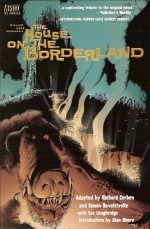
By Simon Revelstroke & Richard Corben (Vertigo)
ISBN: 1-56389-860-8
What’s better, the book or the movie?
This is a highly charged question with only one answer: “It depends.â€
Adapting works from one medium to another is always contentious, and often ill-advised – but the only fair response has to be both highly personal and broadly irrelevant. Just because I don’t like the X-Men films doesn’t make them bad, just as my deep love and admiration for the works of Oliver Postgate and Peter Firmin doesn’t make me six years old (no matter how much I’d like it to be true!).
The real issue is whether an adaptation treats the original fairly or callously exploits it – and make no mistake: 99% of all reworkings are done with money in mind. Half of that other percent point is a genuine desire to proselytise: a mission to “bring the original to the masses†whilst the fractional remainder is an artist’s desire to interpret something that moved them in their own arena of expertise: I’ve wanted for years to adapt the Carnacki the Ghost-Breaker/Ghost-Finder short stories into graphic novel format…
The author of those tales, as well as the source material for this excellent graphic novel from underground comix legends Simon Revelstroke and Richard Corben, is the brilliant William Hope Hodgson. Son of a poor parson, he was born in 1877, and took to sea at 14. In 1899 to make a living he turned to photography and writing.
His stories are dark and moody explorations of terrors internal and ghastly, against a backdrop of eternal, malignant forces beyond human comprehension ever waiting to take the incautious, unwary or overly-inquisitive. As Alan Moore describes in his introduction Hodgson was the point-man for a new kind of story.
The gothic ghost-story writers and high fantasists of Victorian publishing gave way as the century turned to such cosmic horrorists as HP Lovecraft, Robert Bloch and even Clive Barker, and with such epics as The Night Land and The House on the Borderland, Hodgson lit the way. His too brief catalogue of works stands as a beacon of pervasive unease and outright terror and why he’s not a household name I simply can’t fathom. His career was cut tragically short as were so many others in the trenches of World War I.
Rather than religiously translate his masterpiece, Revelstroke and Corben have truncated and marginally updated the book, concentrating on what can actually be visualised – so much of Hodgson’s power comes from the ability to stir the subconscious brain – and in fairness can thus be called a companion rather than adaptation of the original text.
October, 1952: the rural hamlet of Kraighten in the Republic of Ireland. Two English students on a walking tour accidentally provoke the locals and must flee for their lives. They are chased to a ramshackle, desolate ruin on the edge of a crumbling abyss, a misty ravine which harks back to a long-forgotten time.
In the bracken they find an old journal. Scared and still hiding they begin to read the words of Byron Gault, who in 1816 moved himself, his sister Mary and his faithful hound into the infamous but irresistibly inexpensive old house. Of the horrors both physical and otherwise that attacked them and the incredible, infinity-spanning journey that resulted…
How this tale proceeds is a treat I’ll save for your own consumption. This adaptation was nominated for Best Graphic Novel of the Year by the International Horror Guild in 2003. It is not, can not, be the original book. So get both, read both and revel in what makes each unique to their own form, rather than where they can conveniently overlap and coincide.
© 2000 Simon Revelstroke and Richard Corben. All Rights Reserved.
